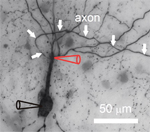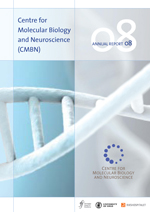
News 2009
CMBN scientist Hua Hu has recently published a paper on signals in interneuron dendrites in Science: Hu H, Martina M, Jonas P (2010) |
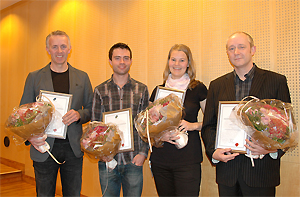
CMBN scientists Magnar Bjørås, James Booth, Ragnhild Weel‐Sneve and Knut Ivan Kristiansen have received Medinnova's Idea Prize for 2009. The scientists are developing a new drug that kills bacteria.
The prize is awarded every year for the best idea with commercial potential from employees in the health region.
Medinnovas Idépris til forskning på nytt bakteriedrepende legemiddel
Aktuelt fra Rikshospitalet, 20 November 2009
 |
Erlend A. Nagelhus, MD, PhD, has started as group leader at the Centre for Molecular Medicine Norway (NCMM), the Nordic EMBL partnership, University of Oslo.
He will run his research group at the Institute of Basic Medical Sciences, in affiliation with CMBN, and be responsible for the neuroimaging activity in Letten Research Centre. Nagelhus' group will focus on roles of aquaporins in brain fluid and vascular dynamics. |
CMBN scientists have recently published a method paper containing an embedded video showing the approach:
Stahl K, Skare Ø, Torp R (2009)
Organotypic cultures as a model of Parkinson's disease. A twist to an old model
TheScientificWorldJOURNAL 9, 811–821
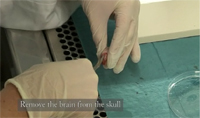
The video can be found on top of page 813 in the PDF (54MB).
Prof. Tone Tønjum is the new director of CMBN starting 1 August 2009. Prof. Jon Storm-Mathisen is the new assistant director.
The former director, Ole Petter Ottersen, is now the rector of the University of Oslo.
The SOBER (Sex On Brain European Research) project seeks for young international molecular biologists or MDs who are interested in a PHD position in Neurobiology.
We will now start interviewing new potential PhD students and post docs. Our next term for employment will start summer/fall 2009. Several positions will be available. We are in SOBER investigating the effects of Gonadotropin Releasing Hormone Receptor blockage on behavior and brain development. We will use a new animal model to evaluate sex specific consequences and mechanisms of a common hormone treatment strategy in human. The main goal of this project is to anticipate a better understanding of the sex specific maturation process in the human brain during puberty and adolescence. If you are young, ambitious have some experience in techniques such as real time PCR and Western blotting., and excited to learn about sex differences in the brain and brain development and become part of a dynamic interdisciplinary team, please contact us for an appointment:
Haraldsen, MD, PhD, i.h.haraldsen@medisin.uio.no, +47 92011533
Mahmood Amiry-Moghaddam, MD, PhD, mahmo@medisin.uio.no, +47 91742177
 |
Bioteknologi brings news on biotechnology and related research. It was distributed with the Norwegian daily Dagens Næringsliv in March 2009. |
CMBN director Ole Petter Ottersen has been elected the new rector of the University of Oslo, together with pro-rector Inga Bostad, and vice-rectors Ragnhild Hennum and Doris Jorde. They will take office on 1 August 2009. Media coverage |
| Johanne Egge Rinholm, a PhD student working with Linda H Bergersen, and collaborating with the groups of David Attwell and Josef Kittler in University College London, has co-authored a paper in Neuron demonstrating how mitochondria are targeted to the postsynaptic side of synapses. Read more...
MacAskill AF, Rinholm JE, Twelvetrees AE, Arancibia-Carcamo IL, Muir J, Fransson A, Aspenstrom P, Attwell D, Kittler JT (2009) Related News and Views: |  |
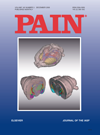
The cover of the December issue of PAIN features an illustration created by CMBN scientist Trine Hjørnevik, showing registration of positron emission tomography (PET) data to a 3-D digital atlas of the rat brain. The 3-D atlas was used to locate nociceptive-related changes in supraspinal metabolic activity measured using FDG-PET. Click on the image for a larger version. |
20 % of Europe’s adult population suffer from chronic pain. Long-lasting pain is a disease in itself, and in order to prevent and improve treatment, it is important to understand the mechanisms underlying the development of chronic pain. Scientists at CMBN have in collaboration with the National Institute of Occupational Health, combined electrophysiological studies with brain scanning using positron emission tomography (PET) to reveal functional changes in neuronal activity after an applied noxious stimulus. The study is the first study published in Norway employing a dedicated small animal PET scanner, which is installed at the Small Animal Imaging Unit at CMBN, and has already achieved attention due to its methodological approach, including the use of a novel digital atlas system, also developed at CMBN (Hjørnevik et al., 2007). It has been shown that animal PET may be applied to study relative functional changes in the brain, and with the high number of available tracers, it is a completely new venue for the scientific community to study the brain function.
Long-lasting pain is believed to be a primitive way of learning, so-called long-term potentiation (LTP). The same way as we develop skills, the experience from a noxious stimulus can be stored in the central nervous system (CNS). Both the electrophysiological study and the PET scans revealed functional changes in neuronal activity at the spinal cord and in brain regions involved in pain processing, respectively. Long-lasting increased activity in the pain pathways might lead to central sensitization, which may cause enhanced pain experience to a noxious stimulus (hyperalgesia) or a non-noxious stimulus to be experienced as painful (allodynia). Hjørnevik T, Jacobsen LM, Qu H, Bjaalie JG, Gjerstad J, Willoch F (2008) Hjørnevik T, Leergaard TB, Darine D, Moldestad O, Dale AM, Willoch F, Bjaalie JG (2007) See also: |
An overview of doctoral degrees at CMBN in 2008 is now available.
 |
Endonuclease V can initiate the repair of deaminated purine bases by recognizing them and hydrolyzing the second phosphodiester bond on their 3' side. Deamination of DNA bases, particularly via nitrosative deamination resulting from endogenous processes and increased by oxidative stress from mitochondrial dysfunction or inflammatory responses, can cause transition mutations and cancer predisposition. Scientists at CMBN have solved structures of endonuclease V in complex with its substrate and product DNA. These structures provide new insight into the initial step of what has been a structurally undefined, but biologically crucial, DNA base repair pathway The structures reveal a wedge motif acting as a minor groove damage sensor and a pocket to recognize the lesion; the enzyme remains tightly bound to the 5' phosphate product, perhaps to hand it over to downstream repair factors.
Dalhus B, Arvai AS, Rosnes I, Olsen ØE, Backe PH, Alseth I, Gao H, Cao W, Tainer JA, Bjørås M (2009) Related News and Views: See also: |
PO Box 1105 Blindern, NO-0317 Oslo, Norway. Tel: +47 22851528. Fax: +47 22851488
